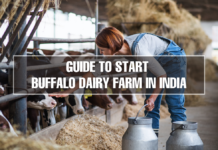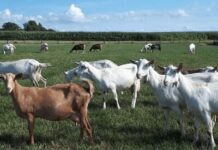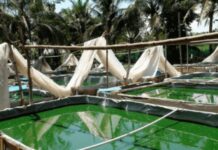
In order to satisfy the need for daily consumption levels, fishes procured from sea and river serve to be inadequate and their over-cultivation of naturally available fishes will affect the fish habitat dramatically. Fish Farming meets demand and provides employment. Large scale producers cater to growing fish to sell in national and international markets, Fish cultivating supplies form a requisite backbone for the aquaculture & pisciculture business. This includes the production of ornamental fish, fish for human consumption (fish food) and recreational fish that are stocked in public ponds and lakes.
In India, a wide variety of species of fish such as Carps- Catla (Catla Catla), rohu Labeo (Labeo Rohita) and mrigal carp (Cirrhinus Mrigala); Catfish- ‘Magur’ (Clarias Batrachus); Murrels- (Channa Striata and C.marulius); Freshwater shrimps- the giant river prawn (Macrobrachium rosenbergii); Green mussel-(Perna Viridis); Japanese pearl oyster (Pinctada fucata) and filter algae have been known to be propagated from modern fish farming methods.
As the number of existing inhabitant fishes influence the readily produced and their natural surroundings, a variety of provisions are available right from feeders, filtration frameworks, growth supplies, warming, and cooling facilities, power, hydroponics, plumbing, predator control measures, tanks, and water treatment infrastructures form the fundamentals. Since Fish Farming fulfills consumer demands and offers employment opportunities, the Government gives sponsorships to farmers to develop the marine ecosystem as a business opportunity and imparting a thought of economic and environmental sustainability.
Generation of employment opportunities
Fisheries is a crucially developing industry witnessed by millennials primitively due to a higher source of protein content. Government agencies and revolving industries recruit for positions such as offshore aquaculture farmer, shellfish cultivation, hatchery technician, biological science technician, fish research assistant, etc. A plethora of career opportunities have evolved in this domain from both the public and private sectors.
From a wider perspective, it covers inland and sea, gears, navigation, oceanography, aquarium management, fish nurturing, processing, export and import of seafood, dependent products, research, and allied activities. It contributes to the national GDP around 1.4% and 4.5% GDP in the form of the agriculture sector as a whole.
Abundant resource of Proteins
Fish farming provides a considerable wellspring of proteins and supplements fundamental for a healthy life. With the progressing world population, fish augments other protein, for instance, animal meat, milk, and beans. Also, fish contains certain omega-3 compounds that aid neurological functionalities, normal development and lessens the dangers of heart disorders. Fish farming has harnessed more amount of animal protein than the cattle industry is what fascinates scientists for what they label- A landmark stage for the betterment of consumer diets.
Interestingly, with the due course of time, fish are easily grown to fatten as a protein-rich aquatic animal because of the technological and nutritional improvements that allow aquaculture to gain momentum, this owes a part clarification for a developing global area of six percent a year since the last five years.
Controls Predators and keeps boundaries from overfishing
Because of expanding the global population, the need for fish consumption grows at a massive outreach. Overfishing happens when fish are being obtained earlier than they can reproduce themselves. It has resulted in adverse effects on biodiversity. As indicated by the reports of the World Wildlife Fund this has caused a genuine marine ecological disturbance prompting the incalculable loss of aquatic life with a huge number of ocean turtles and cetaceans too.
Fish ponds set to meet this need thus by meeting preventive measures of overfishing from the seas and lakes. Another bonus for fish farms is that production is much regulated as they have better control over them, that is, the fluctuations recorded in the fish production and supply is reduced. It doesn’t hold true grounds for the fish population in natural habitats because of their ecological cycle or because they experience overfishing.
Hassle-free maintenance
In comparison with other types of farming methods such as cattle farming and poultry farming, fish farming experiences lower set-up and operating costs. Fish farms can be established at any place that has clean water quality as well as an expanse of water must be abundant. Appropriate maintenance must be taken care of from the very first installment to generate commercial value for the venture.
Aquaculture holds the benefit that it differentiates itself from large-scale sea fishing. It can require less upkeep reckoning farming techniques. They can be built even in little rooms which indicates- fish production can be made available near the doorsteps of the customer. Fish farming can likewise be inculcated at a low cost. Fish growth is made possible inexpensively, and this occupation is bound to improving lifestyles of the masses, jobs, and wellbeing for some of up to 120 million people around the world whose lives are dependent on fishing. It is ascertained that approximately 90 percent of fishermen reside in developing economies, this tells us that their production supports are not limited as a matter of only food for supermarket prospects, but it also opens an incremental avenue for small-scale producers.
High Yields
Particularly while employing several modern fishery cultures in the form of Pisciculture, where better alternatives of cropping methods are implemented while growing fish and rice right one after the other intervals, the rice field acts as a convertible fishpond after its production. Additionally, studies show a larger depth can be extended along the fish culture period that is roughly around 60 cm.
After 1-2 weeks of the harvest period, the underlying area is maintained for fish culture. The expected developed individual fish through this framework has grown up to 100 g and a fish yield of about 2,000kg per hectare is conceivable. Furthermore, it has been reported that fish yield can be able to surpass the household income from rice field under the rotational structure.
Besides, fish nurtured in fish farms are left to evolve over a given timeframe before they are gathered. This method guarantees yields by separating the juvenile fish as against observed in traditional fishing methods.
Fish farming methods have time and again protected predator fishes from noteworthy predators such as Large fishes, sharks, bears, and fish-dependent birds. This instills harmony in the overall fish population giving higher outputs. Moreover, they can be regularly checked for bacteria, illness and other hindrances.
This form of farming helps to restore the masses of some notable fish varieties, in the form of black cod, sea bass & red snapper. The higher market presence of such several fish families facilitates the need for breeding cultures in fish farms to avoid them getting depleted.






